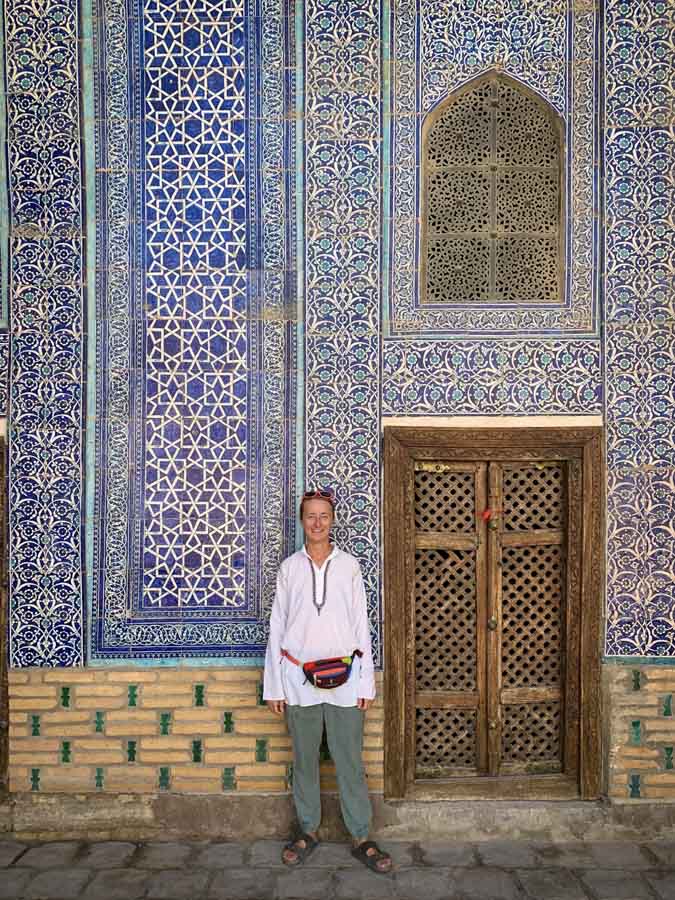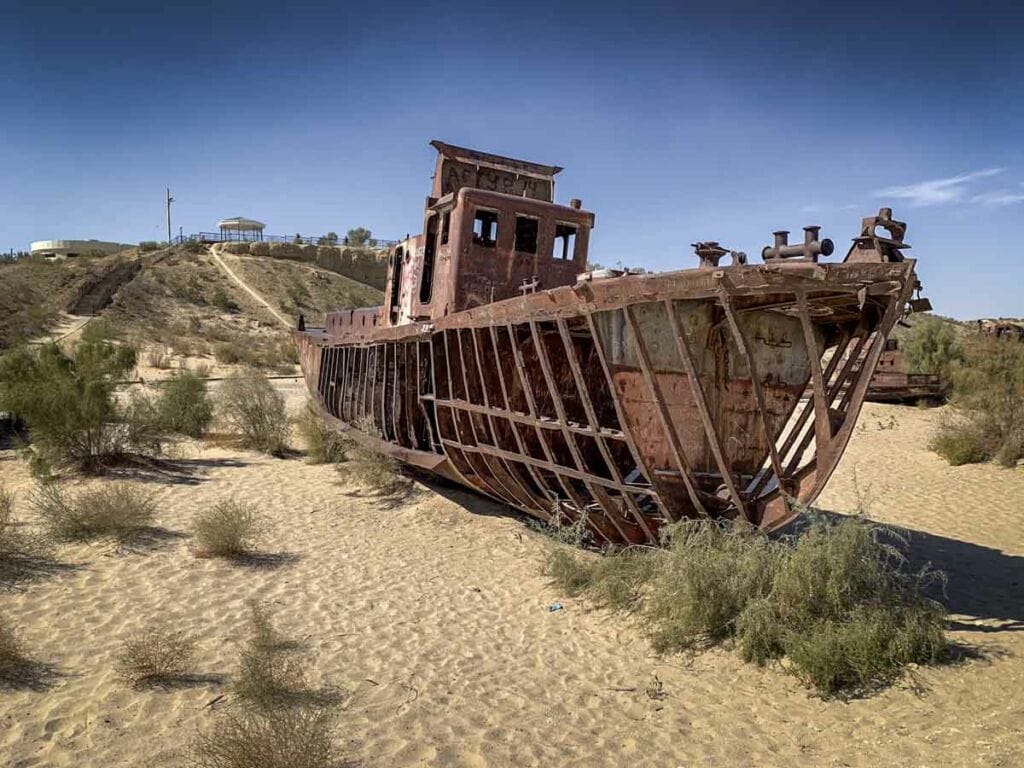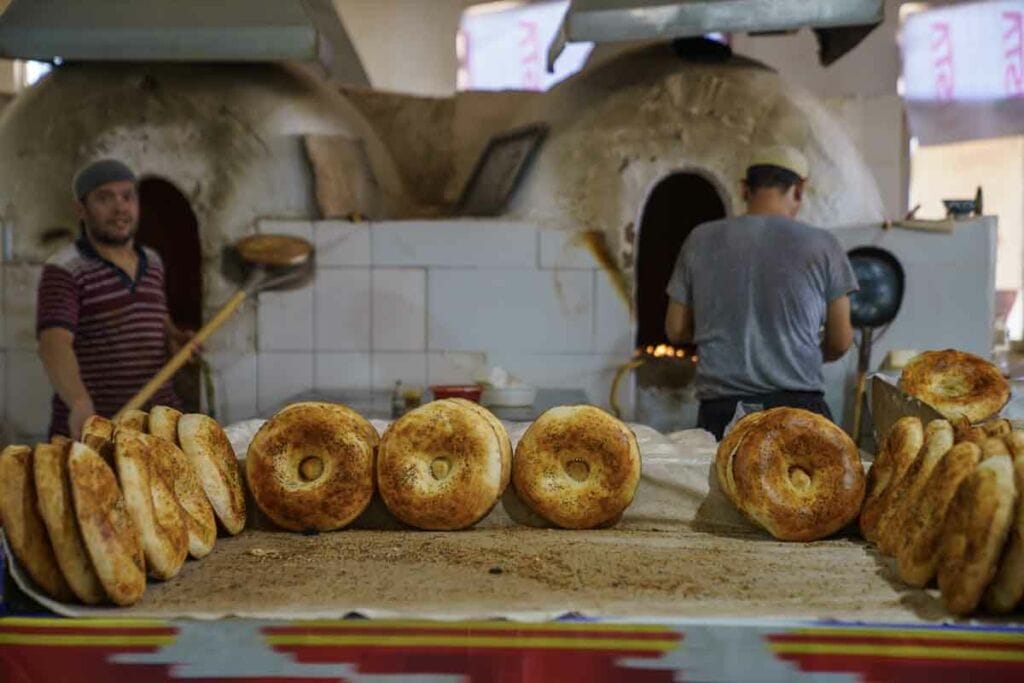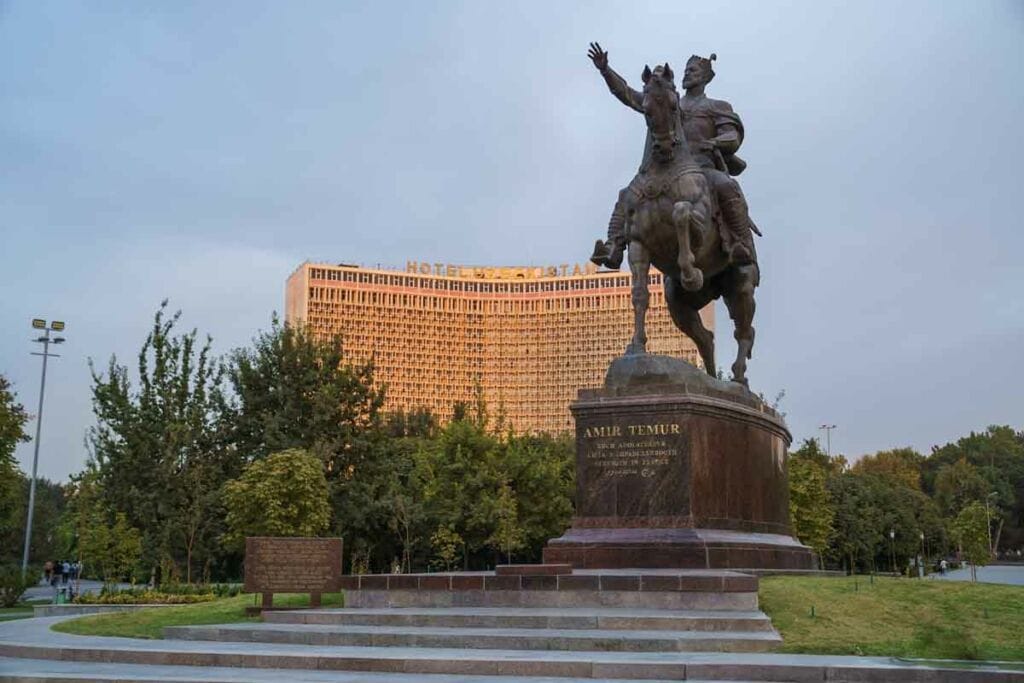Are you planning to travel to Uzbekistan for the first time? You may want to read this article – 16 things we wish we’d known before our trip to Uzbekistan in September 2024!
Uzbekistan was a place we both wanted to visit for a long time, until we found the perfect reason to do it – we decided to take part in the Challenge Samarkand Middle Distance triathlon race, taking place in the famous Silk Road city, held on September 8th, 2024.
After that, we spent a further two weeks travelling around the country, and we loved every second of it. Uzbekistan seemed to hit that ‘sweet spot’ between touristy and undiscovered, with a great tourist infrastructure but no crowds (in most places), affordable prices, and plenty of options for accommodation and sightseeing.
Tourists are kind and welcoming, the food is not bad, and getting around is very easy – provided you plan some things in advance.
Now, travelling to Uzbekistan is not the planning nightmare it was until 7/8 years ago, when visas were notoriously hard to get. However, it’s recommended to have an itinerary ready before you travel to Uzbekistan, as it’s much better to book trains and internal flights in advance.
But I’ll tell you more about all this later. Let’s have a look at our Uzbekistan travel guide -16 important things to know about travelling to Uzbekistan!
1) Uzbekistan Visa
First of all, make sure you check whether you need a visa to travel to Uzbekistan. After decades of complicated post-Soviet visa procedures with invitation letters and long waiting times, e-visa were introduced in Uzbekistan in 2018.
Some nationalities like EU, Australia, UK, US and Canada, get 30-days visa-free entry. If you are not sure whether or not you qualify for visa-free entry, you can easily check on the official e-visa portal, where you can also apply for an e-visa in case you need one.
E-visas are very affordable at just $20 for single and $50 for multiple entry, and waiting times are 2/3 days.
2) Getting to Uzbekistan
Many people visit Uzbekistan as part of a longer trip around Central Asia, also visiting countries like Kazakhstan or Kyrgyzstan, and therefore enter the country from land borders. We haven’t done this so we can only tell you about our experience reaching Uzbekistan by plane.
The two largest airport in Uzbekistan are Tashkent, the capital city, and Samarkand. Since we were travelling to Uzbekistan primarily for our triathlon race which was held in Samarkand, we opted to fly there with Turkish Airlines (via Istanbul).
Samarkand airport is fairly small – there are several daily flights to Moscow and other Russian cities, otherwise the best option for travellers coming from Europe is flying Turkish Airlines, flyDubai via Dubai or WizzAir via Abu Dhabi.
Tashkent offers several more flights – Uzbekistan Airlines flies directly to several European cities, including Milan, Riga, Rome and London, and many destinations around Asia and the Middle East. The airport is also well connected to Russia and other Central Asian countries, especially Kazakhstan. For this reason, flights to Tashkent are usually more affordable compared to Samarkand.
Please note that most flights to Uzbekistan land in the middle of the night, and depart very early in the morning.
3) Where to Go in Uzbekistan
Check out this map of Uzbekistan, and you’ll notice that the country has a really odd shape – this article tells you more about the reason why.
You’ll notice that Taskhent is located in the far eastern part of the country. Most travellers start their Uzbekistan itinerary from Tashkent, then move west to see Samarkand, Bukhara and Khiva, the main ancient Silk Road cities, and some make it as far as Karakalpakstan and the Aral Sea, in the northwestern part of the country.
Other places worth visiting include the Fergana Valley, further east from Tashkent, and the Nuratau and Chimgan mountains.
4) Best Time to Visit Uzbekistan
Together with Liechtenstein, Uzbekistan is the only double landlocked country – a landlocked country that only borders landlocked countries, so you may expect the weather to be a tad extreme.
Summers are brutally hot, with temperatures exceeding 40°, and winters can be freezing – in Tashkent, the mercury rarely rises above 0° in January. The best times to plan a visit to Uzbekistan are spring (April/May) and autumn (September/early November) when the temperatures average around 15°/25°, making sightseeing and exploring comfortable.
If you don’t mind the cold, winter is the quietest season regarding tourist numbers. It is usually around 0°/5° during the day dipping to -15°/20 at night, so if you can handle these temperatures, by all means visit! You may even be lucky and see the ancient Silk Road towns in the snow.
5) How Long to Spend in Uzbekistan
If you have a week to spend in Uzbekistan, you can see Tashkent, Samarkand, Bukhara and Khiva, spending one day in each place. However, I would recommend a minimum of 10 days, to dedicate 2 days to Tashkent, Bukhara and Samarkand, where there’s a lot to see and do.
With 2 weeks in Uzbekistan, you can make your way to Karakalpakstan, a semi-autonomous republic with distinct language and culture, to visit Nukus, Moynaq and even the Aral Sea.
With 3 weeks or longer you can include the Fergana Valley in your itinerary, check out one of the neighbouring countries, or just travel slower and explore away from the hyper-touristed city centre of many Silk Road cities.
6) Book Uzbekistan Trains in Advance
Trains are by far the best way to travel around Uzbekistan. The country is large and mostly covered in desert, roads are not always in great shape and people drive quite recklessly, whereas trains are comfortable, convenient and reliable.
The railway crosses the country from west to east, and all cities mentioned above have a train station. Tashkent, Samarkand and Bukhara are connected by the excellent high-speed Afrosiyob trains, whereas to reach Khiva and Nukus you’ll have to take the slower Soviet-time trains (with sleeper carriages).
Here are travel times and approximate ticket prices between the main cities in Uzbekistan:
- Tashkent-Samarkand: 2 hours 20 on Afrosiyob trains – tickets 245,000 sum (€17)
- Samarkand-Bukhara: 1 hour 40 on Afrosiyob trains – tickets 178,000 sum (€12.50)
- Bukhara-Khiva: 6 hour 30 – tickets 146,000/195,000 sum (€10.50/14)
As you can see, the prices are quite affordable by European standards. The downside is that tickets sell out very quickly, especially during high season – that is the main reason why we recommend planning your itinerary and booking your train tickets in advance.
Tickets are released approximately 45 days in advance, and you can buy them via the official Uzbekistan Railway website. The English version often has bugs, so you’re better off with the Russian version (using Google Translate if you can’t speak Russian).
Once you buy your ticket, you can download a PDF copy and you’ll also get it via email. It is not necessary to have a printed copy, a screenshot with the QR code well visible is enough.
7) Uzbekistan Internal Flights
Trains are the best way to travel around Uzbekistan, but if you want to travel as far as Khiva and Nukus you may want to opt for a domestic flight to save time.
There are daily flights to both Urgench (half an hour drive from Khiva) and Nukus with Uzbekistan Airways from Tashkent Airport. Make sure you ask your taxi to drop you off at the Terminal 3 (Domestic), since the main International terminal is 5 km away!
Book your tickets a few months in advance to get good fares. We flew from Tashkent to Nukus in September 2024 and only paid $60 each booking our tickets two months in advance.
8) Uzbekistan Taxis – Yandex Go App
With the exception of Tashkent and its wonderful metro, Yandex taxis are the best way to get around Uzbek cities.
Make sure you download the Yandex Go app, you’ll need an Uzbek SIM card to validate your profile. Once it’s ready to go, Yandex works pretty much like Uber – enter your location, choose the vehicle type you prefer, and wait to be connected to an available driver. Then you can pay cash or through the app, and also have the option of adding a tip.
Yandex taxis are extremely affordable, with 20-minute rides costing between 15 and 20,000 sum (€1.10/1.60). The price is displayed when you search, just like with Uber, so there’s no need to haggle or worry about being overcharged.
9) Staying Connected in Uzbekistan – SIM Card
All the places we stayed at in Uzbekistan had good Wi-Fi, but we also recommend getting a SIM card when you arrive in the country, to use Yandex and any other apps you might need.
You can easily buy a SIM card at Tashkent and Samarkand airports at various kiosks, where it will also be activated for you. We actually recommend doing this so you’ll be ready to call a Yandex taxi to get to your hotel. Alternatively, there are also phone shops and kiosks in all major cities where you can pick up a local SIM.
We got two Beeline SIM cards simply because there was no line at the kiosk, and paid €10 for 50 GB data each. Payments in euro and USD are accepted in most kiosks.
We had no issues with Beeline and had good connectivity in all the towns we visited, but we got no signal in remote places and on trains. I don’t know if other airlines offer better connection in remote places – please leave us a message if you have experience in this matter!
10) Where to Stay in Uzbekistan
In most Uzbek towns you have the option of staying in hostels, hotels and guesthouses, some of which are run by local families and located in stunning heritage buildings. We opted for a mix of hotels and guesthouses – in Samarkand we stayed in a Hilton hotel close to the start of our triathlon race, otherwise we always chose locally-owned properties.
Here are the places we stayed at – all included breakfast and cost between €50/70 for a double room. It is also worth noticing that as of September 2024, Uzbek hotels also charge a tourist tax of approximately 50,000 sum per person/per night, which is not always included in prices quoted on third-party sites.
- Samarkand: Hilton Afrosiyob
- Tashkent: Sapiens Hotel
- Nukus: Jipek Joli Inn
- Khiva: Meros B&B
- Bukhara: Bibi-Khanym Hotel
Spending a night in a yurt is on the wishlist of many Central Asian travellers. Uzbeks aren’t traditionally nomadic, so you won’t find yurts in Samarkand or Bukhara for example. However, you can stay in yurts in Karakalpakstan – for example in Moynaq or on the shore of the Aral Sea.
11) Hotel Registration
Travellers to Uzbekistan are still required to register where they stay. If you’re just staying in hotels and guesthouses, reception will do it for you. However, don’t forget to collect all your registration slips as immigration agents might ask you to present them upon departure.
According to online reports, registration slips are rarely checked nowadays, but Nick was asked in September 2024 so make sure you have yours ready! Or else, you may be fined up to 3 million sum.
Travellers planning to camp, couchsurf or stay with friends will have to take care of their own registration on the Emehmon website and pay a small fee.
12) Money in Uzbekistan
The local currency in Uzbekistan is the sum (сўм) – at the time of writing, 1 euro was worth 13,800 sum and 1 USD was 12,700 sum.
You can exchange cash from banks, hotels and exchange offices at Tashkent airport, but please be aware that moneychanger offices aren’t commonplace, especially in smaller towns like Khiva or Nukus. At the time of our visit we also found several ATMs in tourist locations, but not all accepted international cards.
Most hotels and restaurants accept international cards, and some of the larger souvenir shops also accept payment in Euro or USD.
We recommend taking some cash with you to exchange as needed, for entrance fees, souvenirs and other small purchases, and using cards to pay for your meals and accommodation.
13) Uzbekistan Travel Costs
Uzbekistan isn’t the cheapest country to visit, but by Western European standards it’s still very affordable.
As mentioned above, we stayed in locally-owned midrange hotels, for about €50/70 with breakfast. Budget hotels cost as little as €20/30 per night.
For a meal, you can expect to pay as little as 35,000 sum (€2.50/3) for Plov, the country’s staple food, while two course dinner in a tourist-oriented restaurant usually cost about €10/15 per person.
Transport is also really affordable, provided you book everything in advance, and Yandex taxis are also super cheap. Also don’t forget to allocate some of your budget towards entrance tickets – most attractions cost 20,000/40,000 sum (€1.40/2.80), with the exception of the Khiva combo ticket (200,000 sum/€14 including entrance to 10 or so places) and the ticket to the Registan complex in Samarkand (65,000 sum/€4.60).
14) Is Uzbekistan Safe?
Absolutely yes. Uzbekistan is one of the safest countries we’ve ever visited – locals are chilled and friendly, no one will hassle you, and in most cities you’ll see ‘tourist police’ near all major sights.
Now, we spent only 3 weeks in the country as a couple, and I can say we never felt unsafe at any time. I also spent a couple of afternoons wandering around by myself, and I was never bothered by anyone. Locals generally minded their own business, or approached me in a friendly manner, to practice their English and have a chat.
The only moment when I felt a bit scared was travelling by car around Karakalpakstan – roads are in terrible state and people drive really fast. I understood why trains are always booked out, they’re a much safer options!
15) What to Eat in Uzbekistan
I don’t think food ranks high on any Central Asian tourist wishlist, but having said that, we were pleasantly surprised!
The best meals we’ve had in Uzbekistan were at Plov restaurants in Bukhara, Samarkand and Tashkent – lunchtime-only restaurants serving the national dish made with rice, beef and carrots, cooked in huge pots over an open fire.
After plov, which is best enjoyed at lunch, we often ate shashlik, meat skewers cooked on the barbecue, usually served with a tomato and cucumber salad. Other traditional dishes are somsa, puff pastries filled with meat, potatoes or other vegetables and often found on the street fresh from the tandir (traditional oven), and manti (boiled dumplings stuffed with meat or veg).
In Khiva, don’t forget to try shivit oshi, a local specialty of dill-flavoured green noodles with a meat or vegetable stew on top, and Tashkent is a wonderful place to eat Korean cuisine, since the town is home to a sizeable Korean community.
16) Language in Uzbekistan
The official language in Uzbekistan is Uzbek, a Turkic language that uses the Latin alphabet. Most people also speak fluent Russian, and we had no problem communicating with people using Google Translate to translate to and from Russian.
In Samarkand and Bukhara, most people are Tajik speakers – the language is completely different from Uzbek, being of Persian origin. In Karakalpakstan people speak Karakalpak, similar to Kazakh.
Sounds confusing, right? There’s no need to worry, most younger people and those who work with tourists also speak good English!









